Stochastic Multi-Objective Scheduling of a Hybrid System in a Distribution Network Using a Mathematical Optimization Algorithm Considering Generation and Demand Uncertainties
Abstract
:1. Introduction
1.1. Motivation
1.2. Literature Review
- −
- The review of previous studies showed that most studies have focused on the optimal allocation of photovoltaic and wind resources alone in the network with optimization goals and methods. Also, some studies have installed HPV/WT systems without considering storage in the electrical network. In a few studies, the scheduling of the HPV/WT system was performed with battery storage in the networks.
- −
- A comprehensive multi-objective function for scheduling the HS in the distribution network has not been well addressed, considering multi-criteria optimization and also considering losses, voltage, cost, and reliability assessments.
- −
- It was found in the literature review that the meta-heuristic algorithms play a crucial role in optimizing energy system scheduling. However, a meta-heuristic algorithm may not be suitable for solving all optimization problems. The No Free Lunch (NFL) theory [25] suggests the need for powerful algorithms that do not converge prematurely in complex problems. Improvements in algorithms are being made to strengthen performance and avoid getting trapped in local optimums, aiming for more accurate solutions.
- −
- Moreover, one of the challenges facing the scheduling of the HS in the distribution network is the uncertainty of renewable production as well as the network load, which has made it difficult for the network operators to accurately evaluate the effectiveness of these types of energy systems, as well as the decision-making process, which, considering the uncertainty, can help to solve this challenge.
- −
- So, the literature review has shown that there is a need to provide a multi-objective framework in the scheduling of the HS, as multi-objective scheduling of the HPV/WT system integrated with battery storage, by providing a comprehensive objective function including minimizing energy losses, voltage deviations, and HS energy costs, plus reliability improvements due to network line outages, using a new improved meta-heuristic algorithm.
1.3. Contributions
- −
- In this study, an optimal multi-objective scheduling framework is implemented for different configurations of the HS, including the HPV/WT/Batt, PV/Batt, and WT/Batt system, in the network to minimize the energy losses, voltage profile, and the HS energy generation cost, and also to enhance its reliability.
- −
- The optimization variables are presented as the site of the HS installation in the distribution network and the size of its components, which are found using a new improved escaping-bird search algorithm (IEBSA). The escape operator from local optimal is used to improve the performance of the conventional escaping-bird search algorithm (EBSA) [26] against premature convergence.
- −
- The unscented transformation (UT) approach [27] is applied to model the uncertainties, such as renewable generation, and also network load. Compared to the MCS, which is very time consuming, the UT has a low calculation time and no presumptions to simplify the model.
- −
- The impact of the battery storage considering the reserve energy management and different configurations of the HS is investigated on the scheduling problem and each of the different objectives.
- −
1.4. Paper Structure
2. Problem Formulation
2.1. Objective Function
2.1.1. Energy Losses
2.1.2. Voltage Deviation
2.1.3. Reliability
2.1.4. Cost of HS
2.2. Constraints
- Power balance constraint
- Voltage of the buses
- Maximum current
- Energy resources number
- Batteries size
3. HS operation and Modeling
3.1. Operation
- If the renewable generation is equal to the load, then the total power produced by the inverter is injected into the grid load.
- If the renewable generation is greater than the load, then 50% of the excess power is saved in the batteries and the rest will be injected into the network.
- If the renewable generation is less than the demand, then the shortage of load power is supplied by discharging the batteries.
3.2. Modeling
3.2.1. PV Model
3.2.2. WT Model
3.2.3. Batt Model
- −
- If renewable energy generation is more than the network load (the demand of a certain bus in the network), the battery is in charge mode (assuming that 50% of the additional power of the sources will be injected into the batteries and the rest will be transferred to the network to supply the specified load). The charge quantity of the battery at time t is computed by
- −
4. Unscented Transformation for Stochastic Modeling
- −
- Step 1: Choose 2n + 1 samples as the initial data for the parameters with uncertainty:
- −
- Step 2: Compute each sample’s weightings:
- −
- Step 3: Sample 2n + 1 indicates the nonlinear function for obtaining the outcome samples in accordance with Equation (30):
- −
- Step 4: Calculate and for variable θ.
5. Proposed Method
5.1. Overview of the EBSA
- ▪
- Calculate the cost.
- ▪
- Under the condition that the cost of is less compared to XAB, XAB replaces it.
- ▪
- Exit the loop after completing the number of evaluations of the cost function relative to the default value (NFEmax).
- −
- For EB based on either the surface maneuver or vertical maneuver, a candidate solution is generated. The transition between the described maneuvers is modeled as follows [26]:
- -
- Calculate the cost of .
- -
- In the case of a lower cost of compared to XEB, XEB replaces it.
- -
- Exit from the main loop as soon as NFE reaches NFEmax.
- -
- Update XGbest.
- -
- Under the the condition that i = N and NFE < MNFEmax, go to Step three; otherwise, leave the loop and go to Step four.
5.2. Overview of the IEBSA
5.3. The Implementation of IEBSA Based on the UT
6. Results and Discussion
6.1. System Data
6.2. Results of Deterministic Scheduling (without Uncertainty)
6.2.1. Results of the Battery Storage Effect
6.2.2. The IEBSA Superiority
6.2.3. Validation of the IEBSA Deterministic Results with a Previous Study
6.3. Results of Stochastic Scheduling (with Uncertainty)
7. Conclusions
- −
- The results showed that the HPV/WT/Batt configuration obtained better objectives than the other combinations such as the lowest values of energy losses, voltage deviations, HS costs, and also the highest reliability levels compared to the other system configurations. The energy losses reduced from 1436.17 kWh to 960.88 kWh, ENS declined from 9.41 MWh to 4.37 MWh, voltage deviations decreased from 0.7602 p.u to 0.2811 p.u and the HS cost obtained was USD 1,455,800. Also, the results showed that the PV/Batt was the weakest configuration in achieving different objectives improvement, especially in hours of network peak load.
- −
- The results showed that integrating the battery storage with the HPV/WT system scheduling decreases the energy losses, ENS, voltage deviations, and also HPV/WT/Batt cost by 0.26%, 10.26%, 0.03%, and 34.62%, respectively, compared to the absence of the storage system.
- −
- The comparison of the IEBSA results with the conventional EBSA, PSO, and GOA algorithms show its superiority in overcoming the premature convergence based on the escape operator from the local optimal and achieving lower values for different objectives. Also, the superior performance of the proposed methodology-based IEBSA was proved when compared to the previous study of ref. [33].
- −
- Results of the stochastic scheduling, based on the UT approach, demonstrated that the energy losses, voltage deviations, and the ENS, and the HPV/WT/Batt energy cost increased due to the consideration of the uncertainties. The low number of sampling points makes this approach an efficient uncertainty model.
- −
- The robust scheduling of the HPV/WT energy system, using battery hydrogen multi-storage, to improve reliability and power quality indices in a distribution network is suggested for future research.
Author Contributions
Funding
Data Availability Statement
Acknowledgments
Conflicts of Interest
Nomenclature
| Active power injected to the network by the HS | Maximum capacity of battery power | ||
| Active power loss | Minimum capacity of battery power | ||
| Ci | cost of agent i | Active load demand | |
| Capital cost | Power loss | ||
| Capital recovery factor | Photovoltaic nominal power | ||
| Current of line i | PSO | Particle swarm optimization | |
| Battery energy at time t | PWT-Nominal | Wind turbine nominal power | |
| Battery energy at time t−1 | Ohmic resistance of the line i | ||
| EBSA | Escaping-bird search algorithm | Reactive load demand | |
| EOLO | Escape from local optimum | Reactive power injected to the network by the HS | |
| Part of objective function | Active power loss | ||
| GOA | Gazelle optimization algorithm | Temc | Temperature of the PV |
| HS | Hybrid system | Temref | temperature of the PV in standard condition |
| i | Annual real interest | UT | Unscented transformation |
| Maximum limit of the line i | Maximum voltage of bus i | ||
| Minimum limit of the line i | Minimum voltage of bus i | ||
| IEBSA | Improved escaping-bird search algorithm | Average of buses voltage | |
| MPAB | Maneuverability of the predator bird | vcin | Cut-in wind speed |
| MPEB | Maneuverability of the prey bird | vcout | Cut-out wind speed |
| n | Number of uncertain parameters | vr | Rated wind speed |
| Number of buses | Vi | Vector of velocity | |
| Nbr | Interest rate (%) | XAB | Positions of predator |
| Nl | Cost of energy (USD/kWh) | XEB | Positions of predator and prey birds |
| Loss of energy (kWh) | Weighted coefficient | ||
| Harmony Search Algorithm | Capital cost | ||
| Improved Grasshopper Optimization Algorithm | Mean of the uncertain parameter | ||
| OF | Adsorption intensity | Covariance of the uncertain parameter |
Appendix A
References
- Zhang, X.; Wang, Y.; Yuan, X.; Shen, Y.; Lu, Z.; Wang, Z. Adaptive dynamic surface control with disturbance observers for battery/supercapacitor-based hybrid energy sources in electric vehicles. IEEE Trans. Transp. Electrif. 2022, 99, 1–11. [Google Scholar] [CrossRef]
- Al-Najjar, H.; El-Khozondar, H.J.; Pfeifer, C.; Al Afif, R. Hybrid grid-tie electrification analysis of bio-shared renewable energy systems for domestic application. Sustain. Cities Soc. 2022, 77, 103538. [Google Scholar] [CrossRef]
- Jiang, J.; Zhang, L.; Wen, X.; Valipour, E.; Nojavan, S. Risk-based performance of power-to-gas storage technology integrated with energy hub system regarding downside risk constrained approach. Int. J. Hydrogen Energy 2022, 47, 39429–39442. [Google Scholar] [CrossRef]
- Dini, A.; Pirouzi, S.; Norouzi, M.; Lehtonen, M. Grid-connected energy hubs in the coordinated multi-energy management based on day-ahead market framework. Energy 2019, 188, 116055. [Google Scholar] [CrossRef]
- Zhang, X.; Lu, Z.; Yuan, X.; Wang, Y.; Shen, X. L2-gain adaptive robust control for hybrid energy storage system in electric vehicles. IEEE Trans. Power Electron. 2020, 36, 7319–7332. [Google Scholar] [CrossRef]
- Kilic, M.; Altun, A.F. Dynamic modelling and multi-objective optimization of off-grid hybrid energy systems by using battery or hydrogen storage for different climates. Int. J. Hydrogen Energy 2023, 48, 22834–22854. [Google Scholar] [CrossRef]
- Wang, Z.; Zhao, D.; Guan, Y. Flexible-constrained time-variant hybrid reliability-based design optimization. Struct. Multidiscip. Optim. 2023, 66, 89. [Google Scholar] [CrossRef]
- Nowdeh, S.A.; Davoudkhani, I.F.; Moghaddam, M.H.; Najmi, E.S.; Abdelaziz, A.Y.; Ahmadi, A.; Razavi, S.E.; Gandoman, F.H. Fuzzy multi-objective placement of renewable energy sources in distribution system with objective of loss reduction and reliability improvement using a novel hybrid method. Appl. Soft Comput. 2019, 77, 761–779. [Google Scholar] [CrossRef]
- Hamanah, W.M.; Abido, M.A.; Alhems, L.M. Optimum sizing of hybrid pv, wind, battery and diesel system using lightning search algorithm. Arab. J. Sci. Eng. 2020, 45, 1871–1883. [Google Scholar] [CrossRef]
- Fathy, A.; Kaaniche, K.; Alanazi, T.M. Recent approach based social spider optimizer for optimal sizing of hybrid PV/wind/battery/diesel integrated microgrid in Aljouf region. IEEE Access 2020, 8, 57630–57645. [Google Scholar] [CrossRef]
- Diab, A.A.Z.; Sultan, H.M.; Kuznetsov, O.N. Optimal sizing of hybrid solar/wind/hydroelectric pumped storage energy system in Egypt based on different meta-heuristic techniques. Environ. Sci. Pollut. Res. 2020, 27, 32318–32340. [Google Scholar] [CrossRef] [PubMed]
- Davoudkhani, I.F.; Dejamkhooy, A.; Nowdeh, S.A. A novel cloud-based framework for optimal design of stand-alone hybrid renewable energy system considering uncertainty and battery aging. Appl. Energy 2023, 344, 121257. [Google Scholar] [CrossRef]
- Suresh, M.; Meenakumari, R. An improved genetic algorithm-based optimal sizing of solar photovoltaic/wind turbine generator/diesel generator/battery connected hybrid energy systems for standalone applications. Int. J. Ambient Energy 2021, 42, 1136–1143. [Google Scholar] [CrossRef]
- Das, B.K.; Hasan, M.; Rashid, F. Optimal sizing of a grid-independent PV/diesel/pump-hydro hybrid system: A case study in Bangladesh. Sustain. Energy Technol. Assess. 2021, 44, 100997. [Google Scholar] [CrossRef]
- Okundamiya, M.S. Size optimization of a hybrid photovoltaic/fuel cell grid connected power system including hydrogen storage. Int. J. Hydrogen Energy 2021, 46, 30539–30546. [Google Scholar] [CrossRef]
- Deng, W.; Zhang, Y.; Tang, Y.; Li, Q.; Yi, Y. A neural network-based adaptive power-sharing strategy for hybrid frame inverters in a microgrid. Front. Energy Res. 2023, 10, 1082948. [Google Scholar] [CrossRef]
- Arabi Nowdeh, S.; Nasri, S.; Saftjani, P.B.; Naderipour, A.; Abdul-Malek, Z.; Kamyab, H.; Jafar-Nowdeh, A. Multi-criteria optimal design of hybrid clean energy system with battery storage considering off-and on-grid application. J. Clean. Prod. 2021, 290, 125808. [Google Scholar] [CrossRef]
- Naderipour, A.; Abdul-Malek, Z.; Nowdeh, S.A.; Ramachandaramurthy, V.K.; Kalam, A.; Guerrero, J.M. Optimal allocation for combined heat and power system with respect to maximum allowable capacity for reduced losses and improved voltage profile and reliability of microgrids considering loading condition. Energy 2020, 196, 117124. [Google Scholar] [CrossRef]
- Cai, T.; Dong, M.; Chen, K.; Gong, T. Methods of participating power spot market bidding and settlement for renewable energy systems. Energy Rep. 2022, 8, 7764–7772. [Google Scholar]
- Ali, Z.M.; Diaaeldin, I.M.; El-Rafei, A.; Hasanien, H.M.; Aleem, S.H.A.; Abdelaziz, A.Y. A novel distributed generation planning algorithm via graphically-based network reconfiguration and soft open points placement using Archimedes optimization algorithm. Ain Shams Eng. J. 2021, 12, 1923–1941. [Google Scholar] [CrossRef]
- Alanazi, A.; Alanazi, M.; Abdelaziz, A.Y.; Kotb, H.; Milyani, A.H.; Azhari, A.A. Stochastic Allocation of Photovoltaic Energy Resources in Distribution Systems Considering Uncertainties Using New Improved Meta-Heuristic Algorithm. Processes 2022, 10, 2179. [Google Scholar] [CrossRef]
- Ngouleu, C.A.W.; Koholé, Y.W.; Fohagui, F.C.V.; Tchuen, G. Techno-economic analysis and optimal sizing of a battery-based and hydrogen-based standalone photovoltaic/wind hybrid system for rural electrification in Cameroon based on meta-heuristic techniques. Energy Convers. Manag. 2023, 280, 116794. [Google Scholar] [CrossRef]
- Arasteh, A.; Alemi, P.; Beiraghi, M. Optimal allocation of photovoltaic/wind energy system in distribution network using meta-heuristic algorithm. Appl. Soft Comput. 2021, 109, 107594. [Google Scholar] [CrossRef]
- Feng, L.; Liu, J.; Lu, H.; Liu, B.; Chen, Y.; Wu, S. Robust operation of distribution network based on photovoltaic/wind energy resources in condition of COVID-19 pandemic considering deterministic and probabilistic approaches. Energy 2022, 261, 125322. [Google Scholar] [CrossRef]
- Kamel, S.; Abdel-Mawgoud, H.; Alrashed, M.M.; Nasrat, L.; Elnaggar, M.F. Optimal allocation of a wind turbine and battery energy storage systems in distribution networks based on the modified BES-optimizer. Front. Energy Res. 2023, 11, 1100456. [Google Scholar] [CrossRef]
- Wolpert, D.H.; Macready, W.G. No free lunch theorems for optimization. IEEE Trans. Evol. Comput. 1997, 1, 67–82. [Google Scholar] [CrossRef]
- Shahrouzi, M.; Kaveh, A. An efficient derivative-free optimization algorithm inspired by avian life-saving manoeuvres. J. Comput. Sci. 2022, 57, 101483. [Google Scholar] [CrossRef]
- Nowdeh, S.A.; Naderipour, A.; Davoudkhani, I.F.; Guerrero, J.M. Stochastic optimization–based economic design for a hybrid sustainable system of wind turbine, combined heat, and power generation, and electric and thermal storages considering uncertainty: A case study of Espoo, Finland. Renew. Sustain. Energy Rev. 2023, 183, 113440. [Google Scholar] [CrossRef]
- Kennedy, J.; Eberhart, R. Particle swarm optimization. In Proceedings of the ICNN’95-International Conference on Neural Networks, Perth, WA, Australia, 27 November–1 December 1995; Volume 4, pp. 1942–1948. [Google Scholar]
- Agushaka, J.O.; Ezugwu, A.E.; Abualigah, L. Gazelle Optimization Algorithm: A novel nature-inspired metaheuristic optimizer. Neural Comput. Appl. 2023, 35, 4099–4131. [Google Scholar] [CrossRef]
- Qaraad, M.; Amjad, S.; Hussein, N.K.; Elhosseini, M.A. An innovative quadratic interpolation salp swarm-based local escape operator for large-scale global optimization problems and feature selection. Neural Comput. Appl. 2022, 34, 17663–17721. [Google Scholar] [CrossRef]
- Qaraad, M.; Amjad, S.; Hussein, N.K.; Badawy, M.; Mirjalili, S.; Elhosseini, M.A. Photovoltaic parameter estimation using improved moth flame algorithms with local escape operators. Comput. Electr. Eng. 2023, 106, 108603. [Google Scholar] [CrossRef]
- Baran, M.E.; Wu, F.F. Network reconfiguration in distribution systems for loss reduction and load balancing. IEEE Trans. Power Deliv. 1989, 4, 1401–1407. [Google Scholar] [CrossRef]
- Javad Aliabadi, M.; Radmehr, M. Optimization of hybrid renewable energy system in radial distribution networks considering uncertainty using meta-heuristic crow search algorithm. Appl. Soft Comput. 2021, 107, 107384. [Google Scholar] [CrossRef]
- Rahiminejad, A.; Vahidi, B.; Hejazi, M.A.; Shahrooyan, S. Optimal scheduling of dispatchable distributed generation in smart environment with the aim of energy loss minimization. Energy 2016, 116, 190–201. [Google Scholar] [CrossRef]

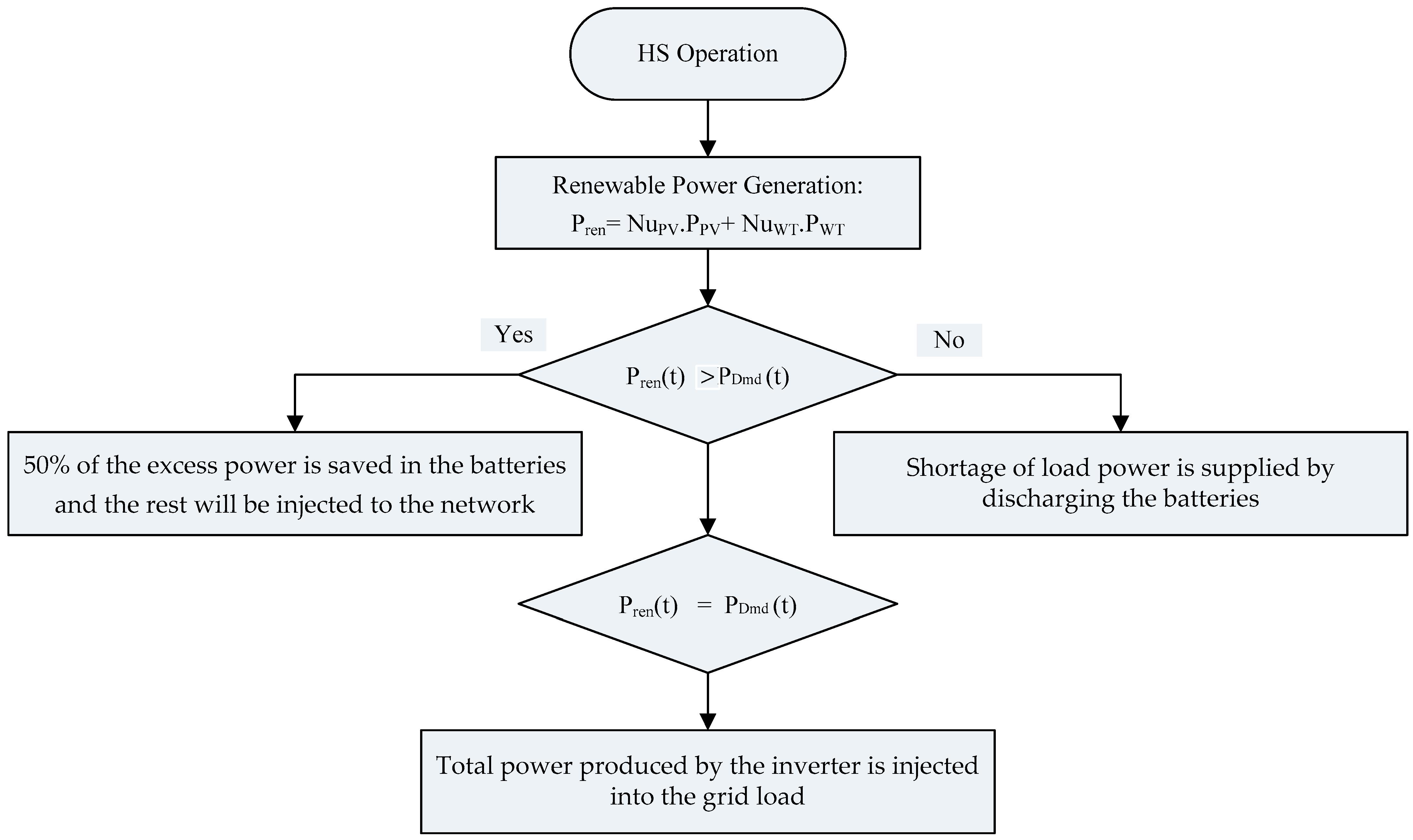

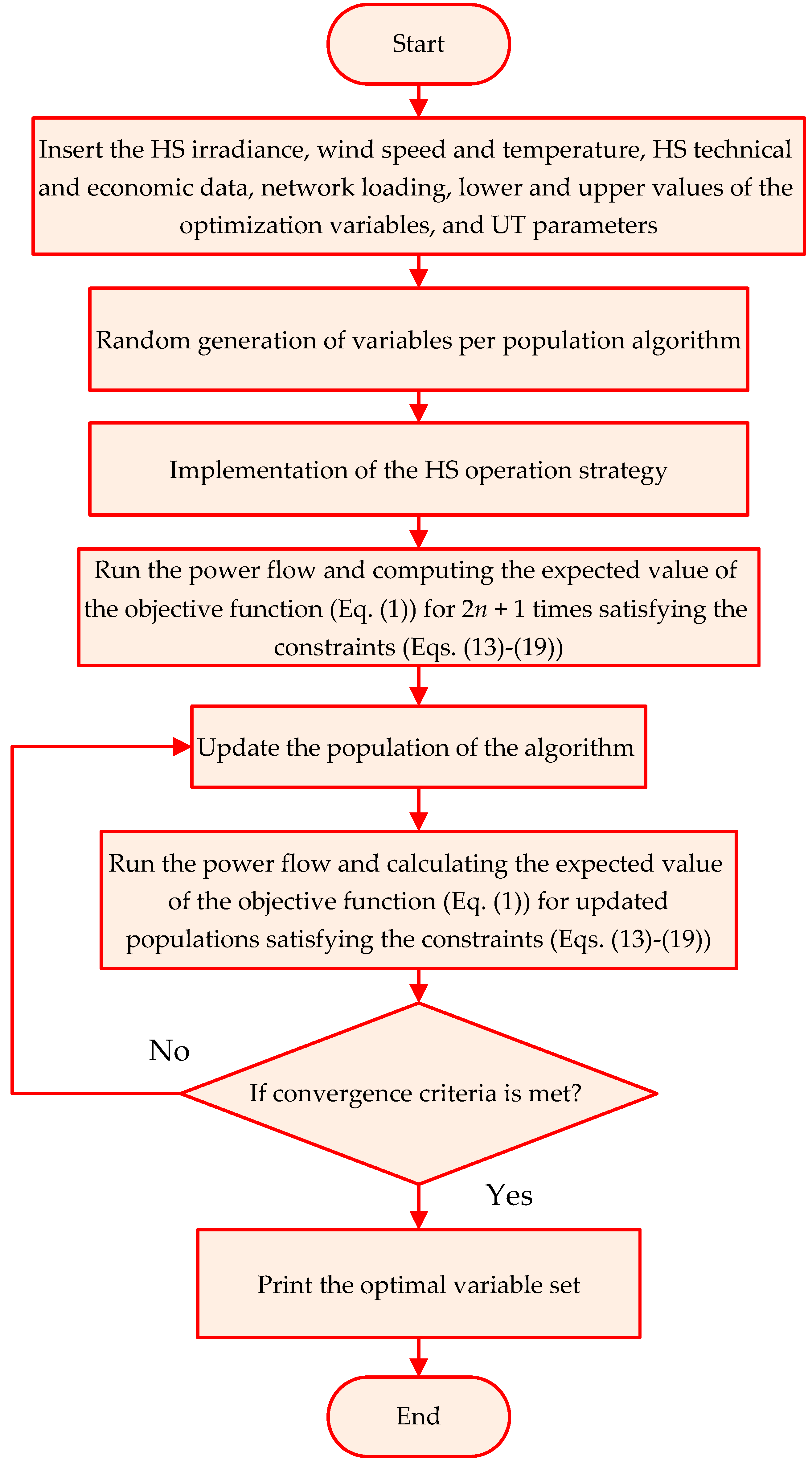



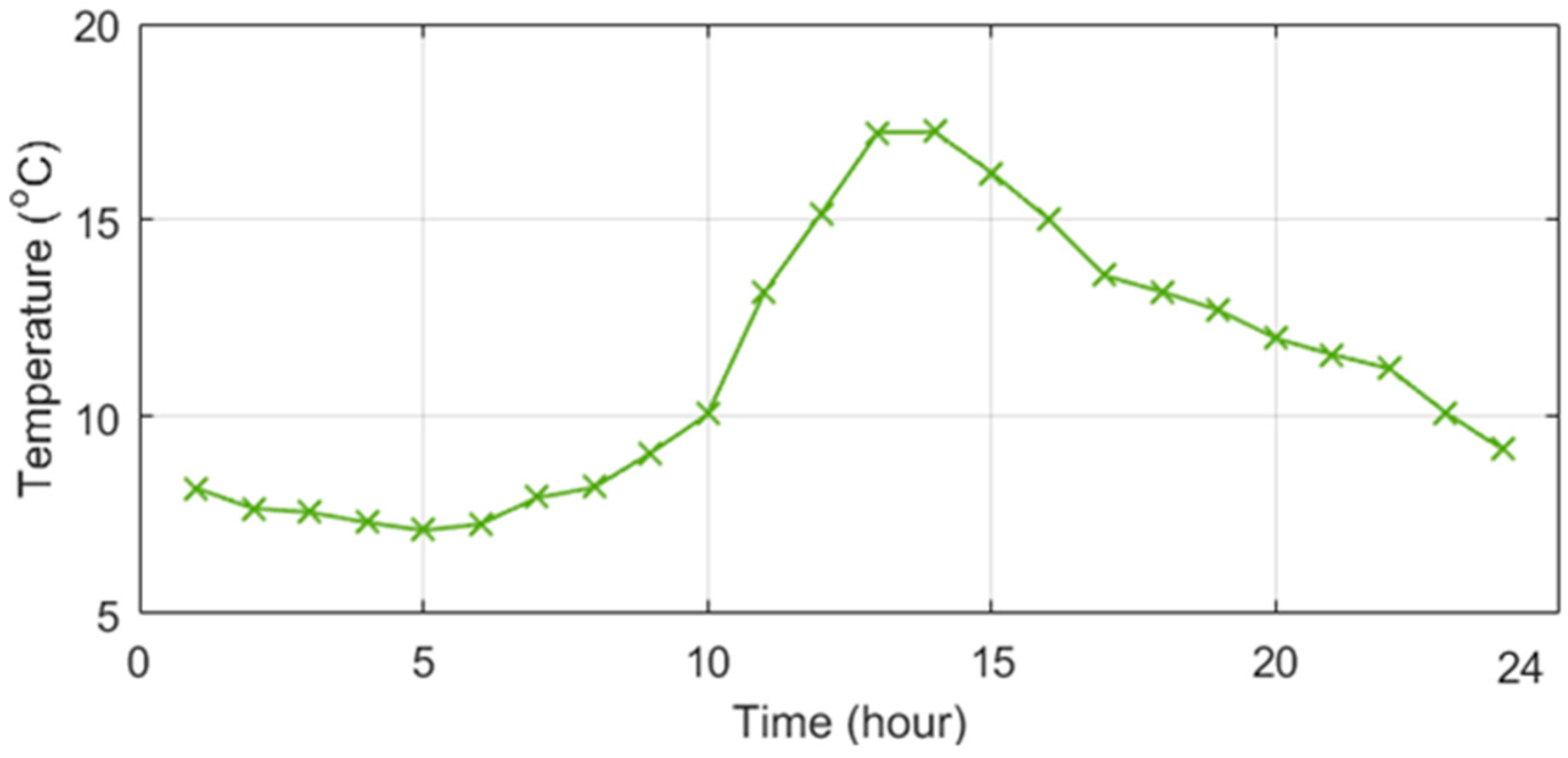



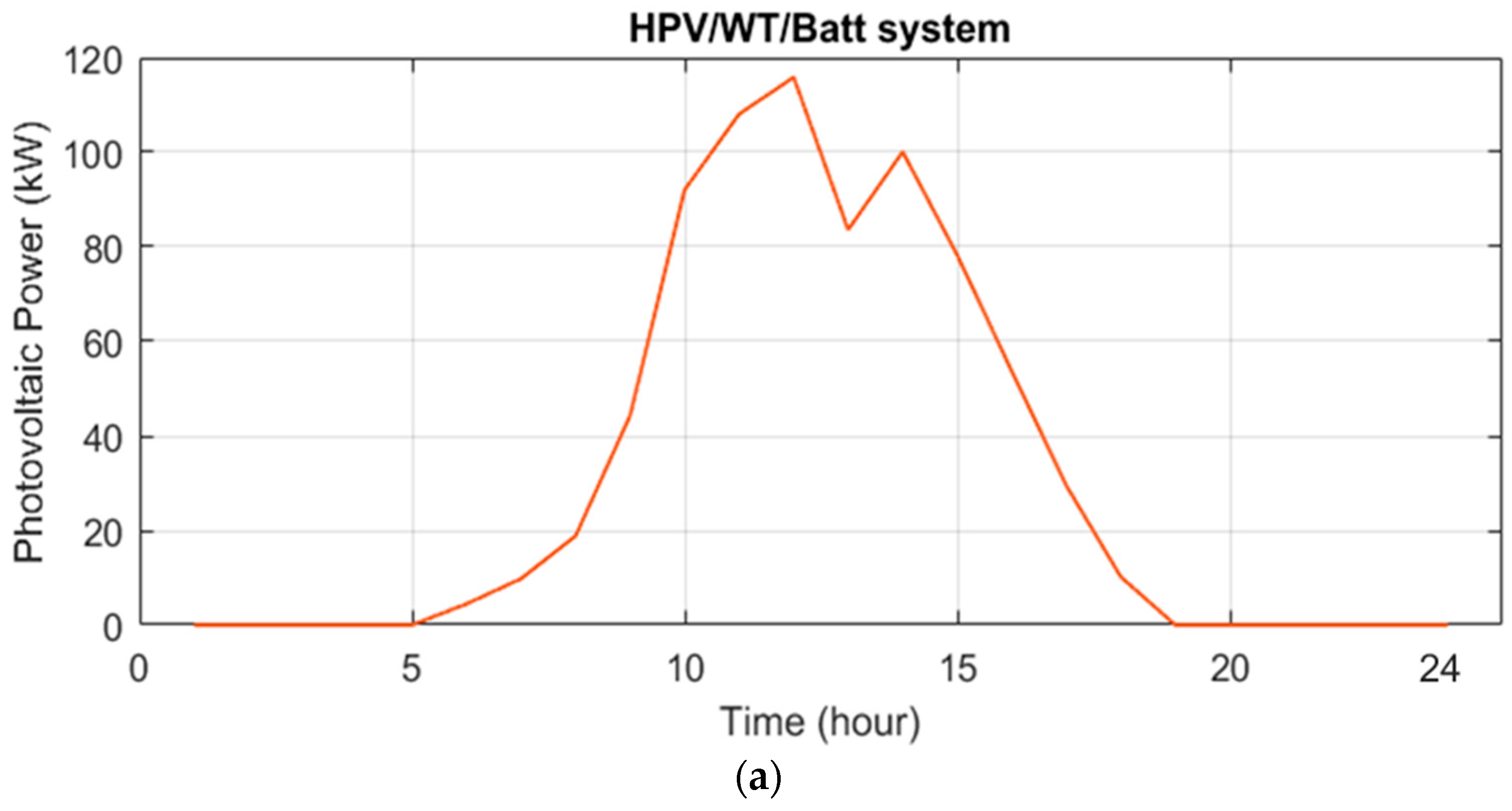
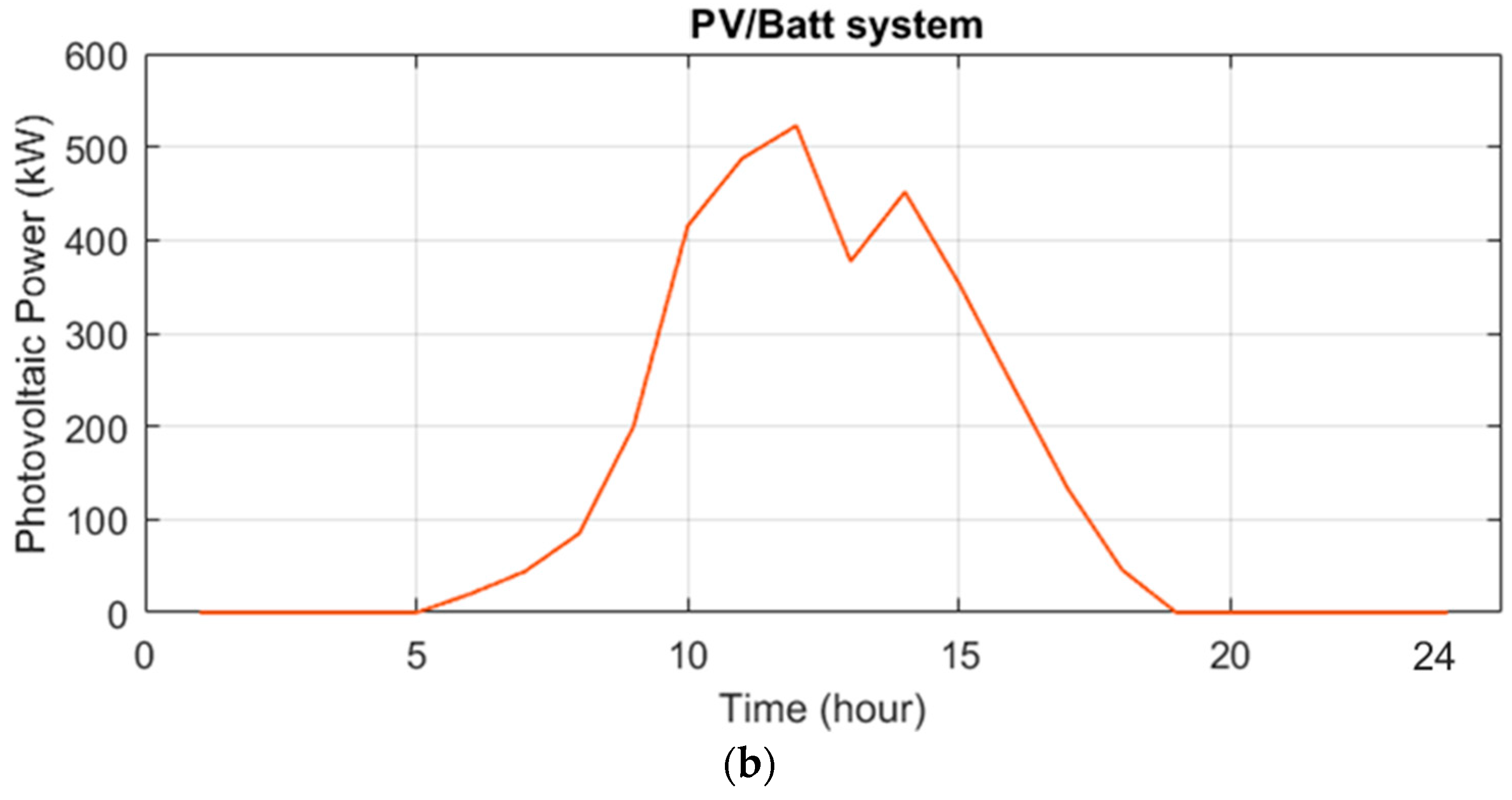
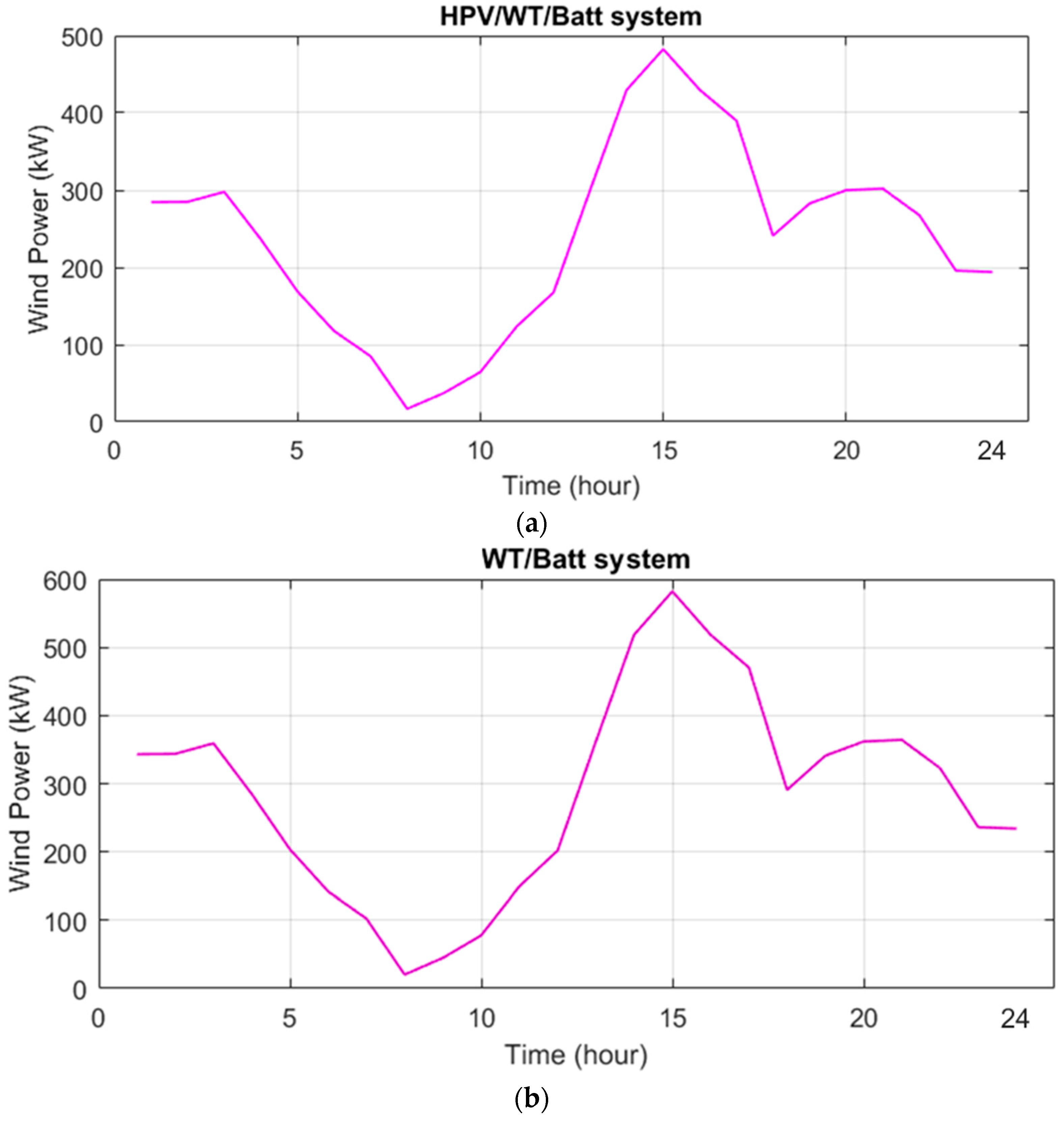
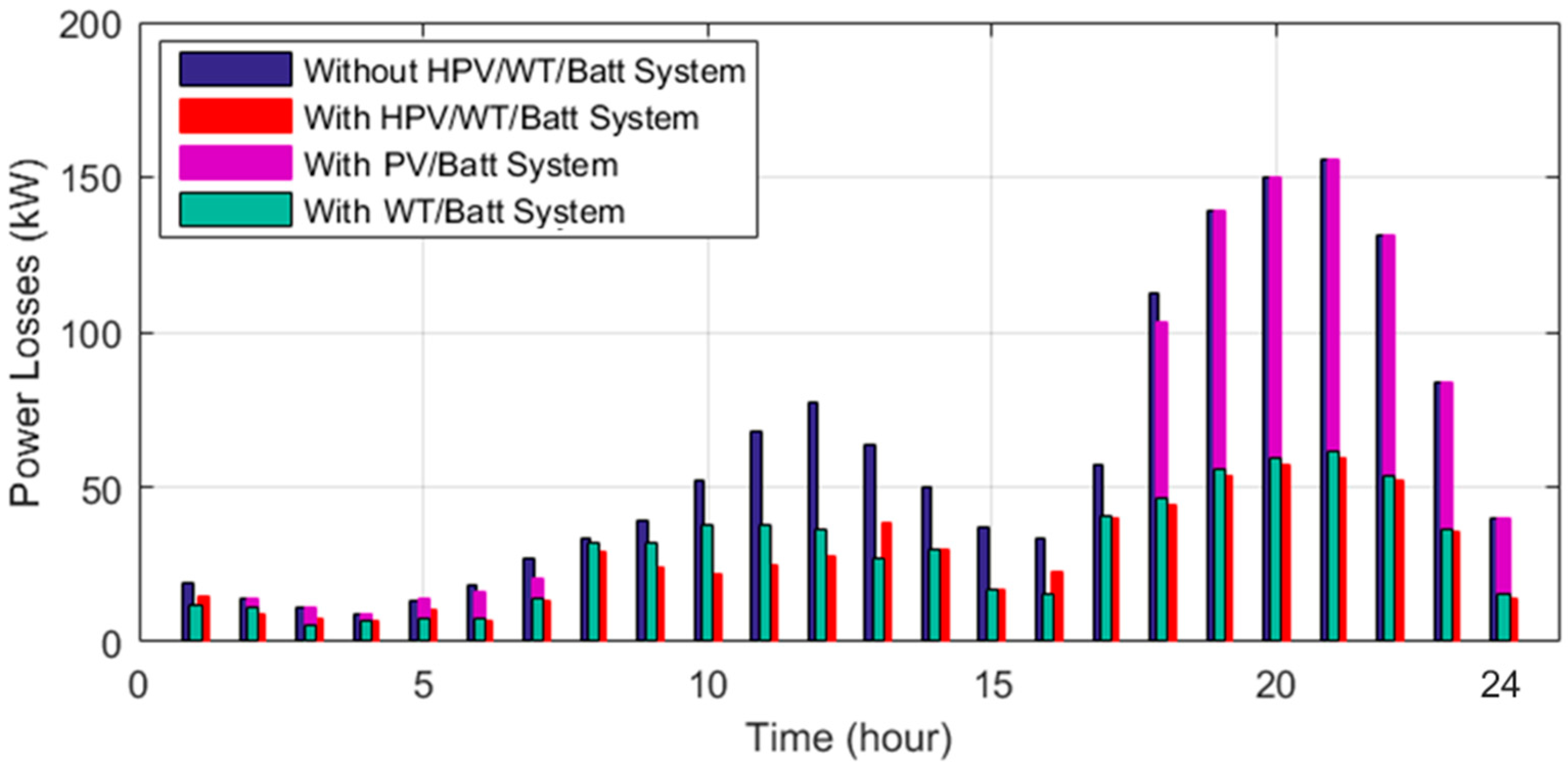
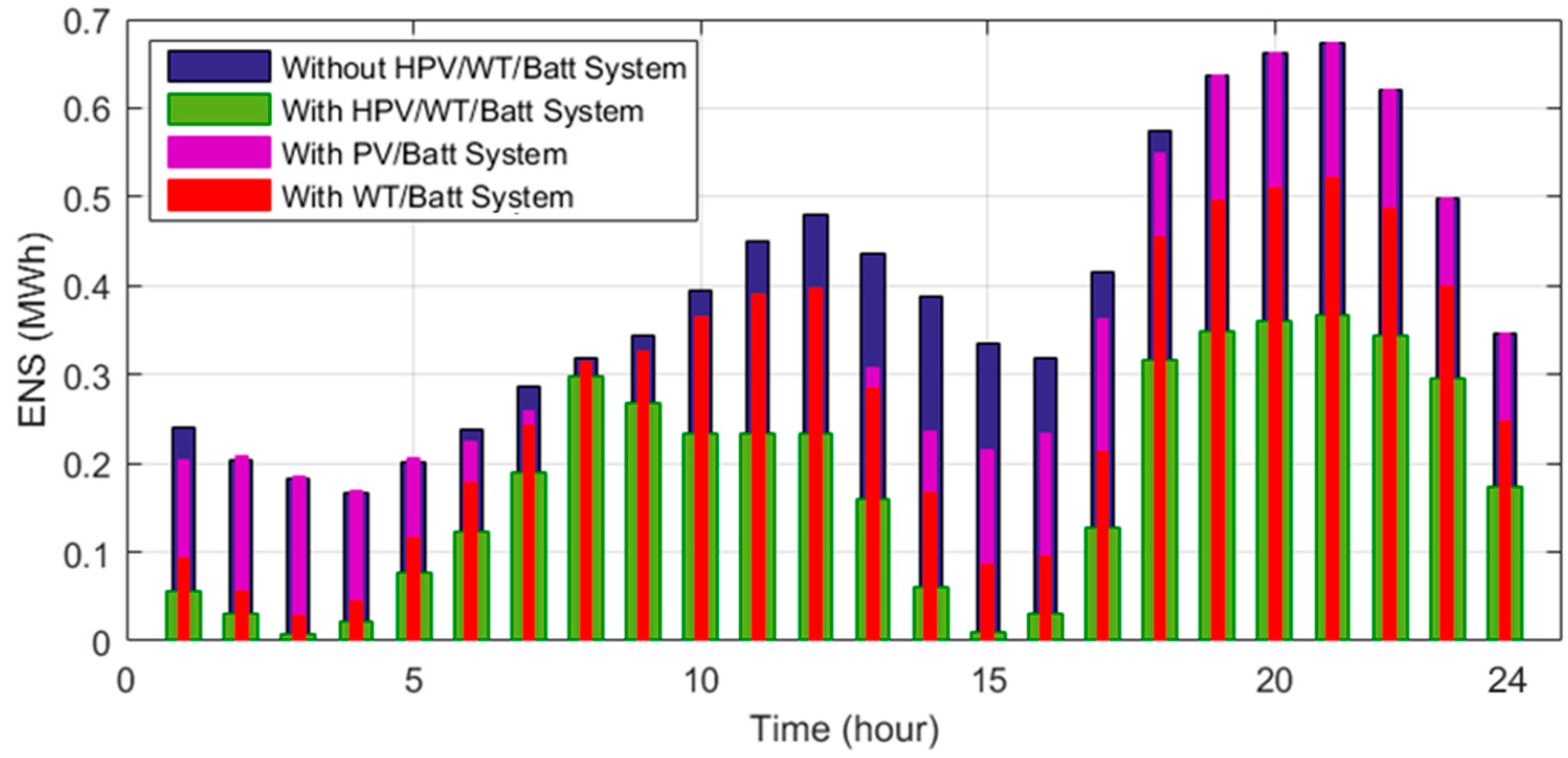
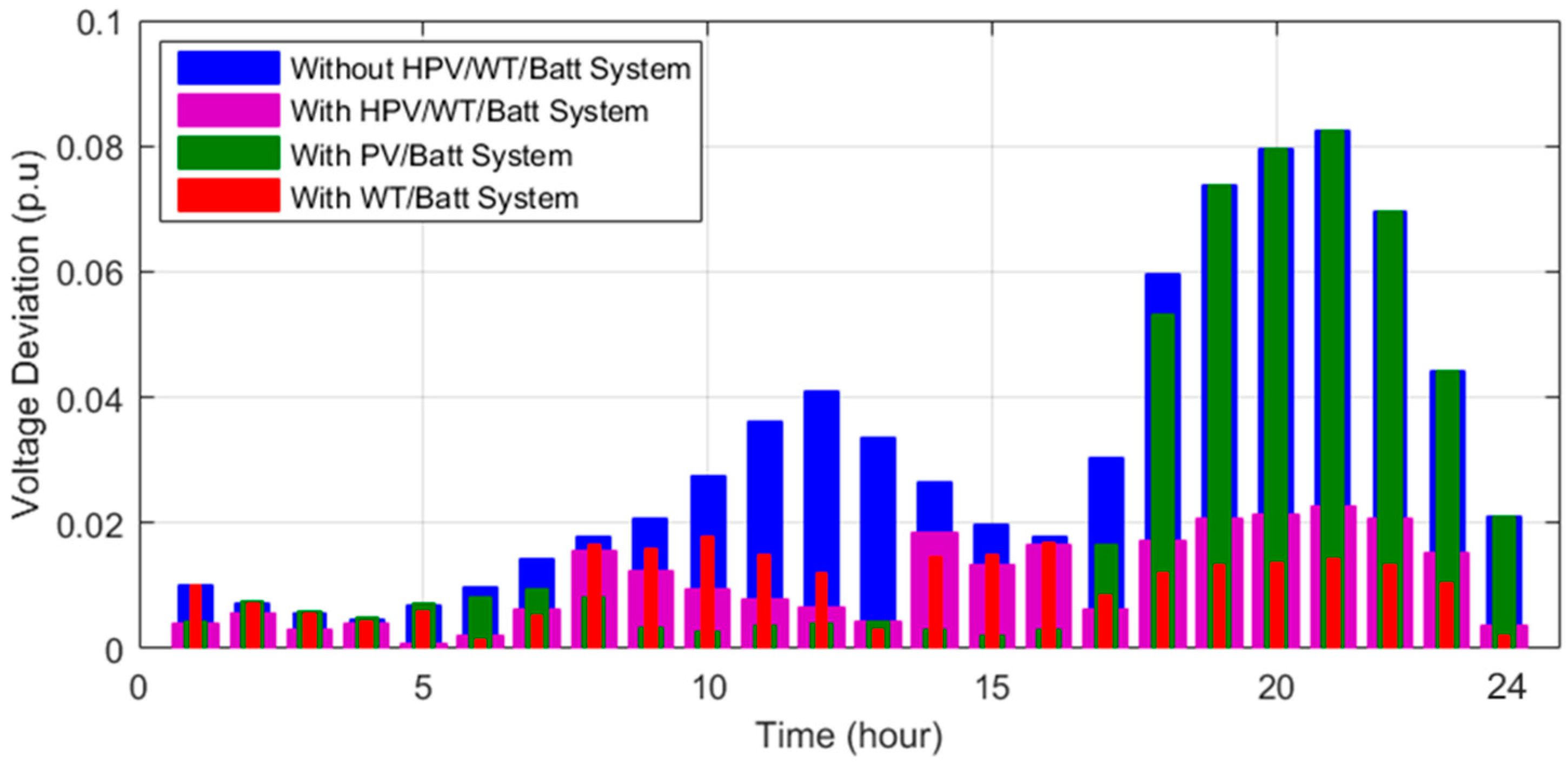

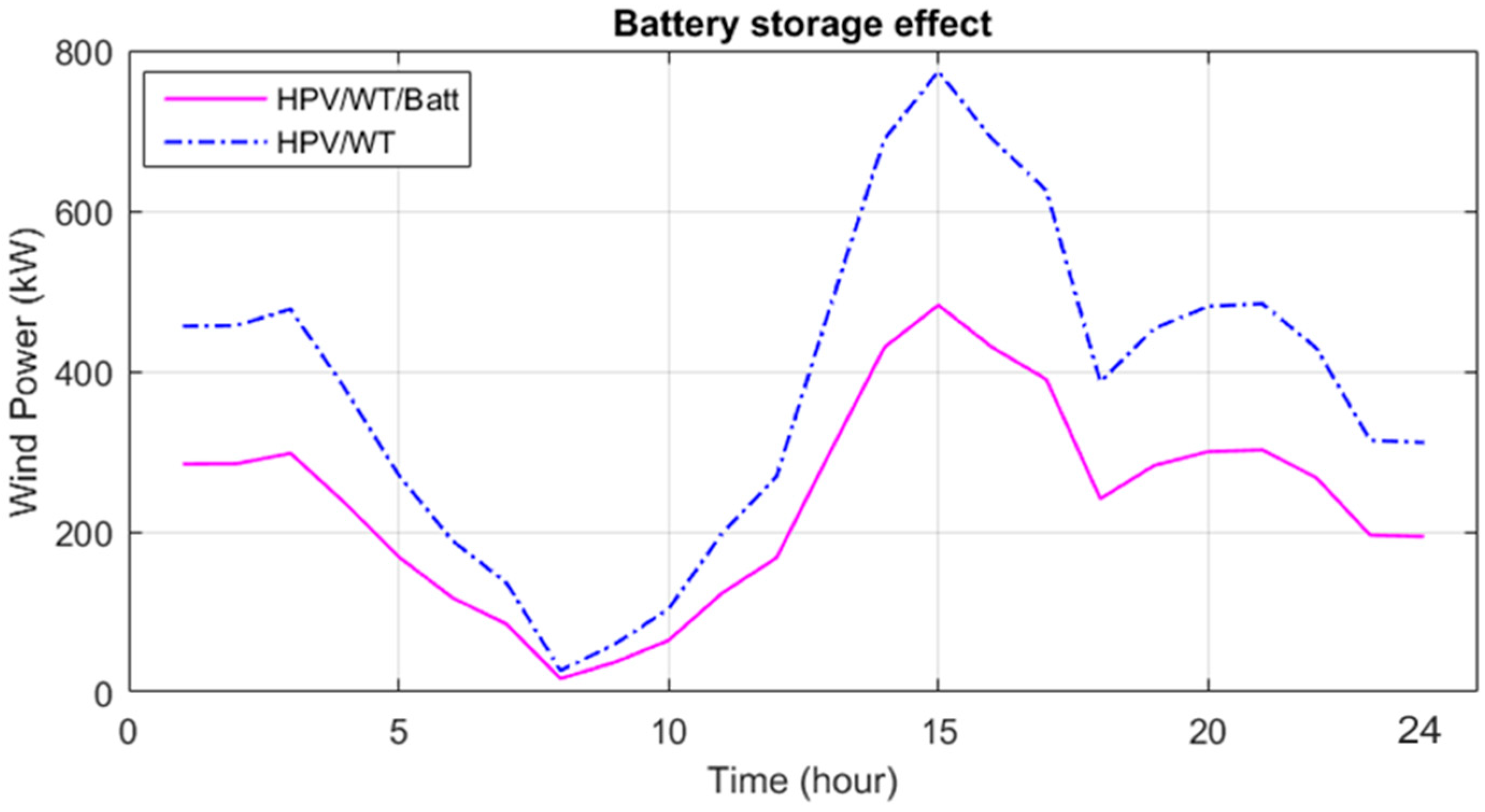
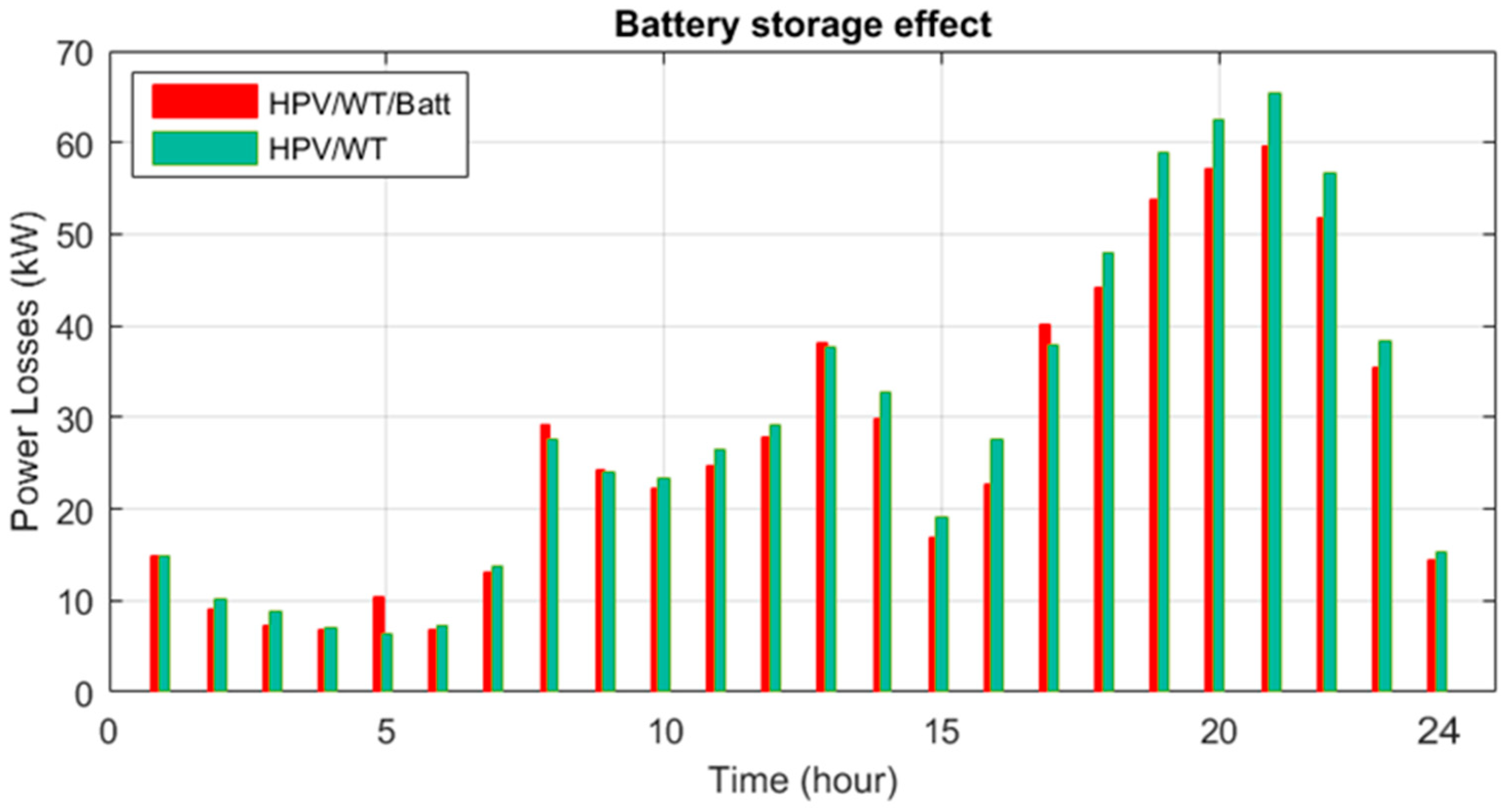



| Ref. | HS * Components | Objective Function | UT | Improved Solver | |||||
|---|---|---|---|---|---|---|---|---|---|
| PV | WT | Battery | Loss | Voltage | Cost | Reliability | |||
| [9] | Yes | No | Yes | No | No | Yes | No | No | No |
| [10] | Yes | Yes | Yes | No | No | Yes | Yes | No | No |
| [11] | Yes | Yes | Yes | No | No | Yes | Yes | No | Yes |
| [12] | Yes | Yes | Yes | No | No | Yes | Yes | No | No |
| [13] | Yes | Yes | Yes | No | No | Yes | Yes | No | Yes |
| [14] | Yes | No | No | No | No | Yes | No | No | No |
| [15] | Yes | Yes | Yes | No | No | Yes | Yes | No | Yes |
| [16] | Yes | Yes | Yes | No | No | Yes | Yes | No | No |
| [17] | Yes | Yes | Yes | No | No | Yes | Yes | No | No |
| [18] | Yes | No | No | Yes | Yes | Yes | No | No | No |
| [19] | Yes | Yes | No | No | Yes | No | Yes | No | No |
| [20] | Yes | No | No | Yes | Yes | No | No | No | Yes |
| [21] | Yes | Yes | No | Yes | No | No | Yes | No | No |
| [22] | Yes | Yes | Yes | Yes | Yes | No | No | No | Yes |
| [23] | Yes | Yes | No | Yes | No | Yes | Yes | No | No |
| [24] | No | Yes | No | Yes | No | No | No | No | Yes |
| This Paper | Yes | Yes | Yes | Yes | Yes | Yes | Yes | Yes | Yes |
| Parameters | Values |
|---|---|
| Nominal power | 1 kW |
| Lifetime | 20 years |
| Reference irradiance | 1000 W/m2 |
| Reference temperature | 25 °C |
| Temperature coefficient | −0.0037 |
| Capital cost | USD 2000 |
| Operation and maintenance cost | 33 USD/year |
| Parameters | Values |
|---|---|
| Nominal power | 1 kW |
| lifetime | 20 years |
| Vcin | 3 m/s |
| Vcout | 20 m/s |
| Vr | 13 m/s |
| Capital cost | USD 3200 |
| Operation and maintenance cost | 100 USD/year |
| Parameters | Values |
|---|---|
| Maximum capacity | 1 kAh |
| Minimum capacity | 0.2 kAh |
| Charge efficiency | 0.9 |
| Discharge efficiency | 0.9 |
| Depth of discharge | 0.8 |
| lifetime | 5 years |
| Capital cost | USD 100 |
| Operation and maintenance cost | 5 USD/year |
| Item/Value | Base Network | With HPV/WT/Batt | With PV/Batt | With WT/Batt |
|---|---|---|---|---|
| Number of WTs | -- | 488 | 606 | -- |
| Number of PVs | -- | 134 | -- | 589 |
| Number of Batts | -- | 648 | 11 | 986 |
| Installation Location (@Bus) | -- | @30 | @12 | @10 |
| Annual Energy Losses (kWh) | 1436.17 | 960.88 | 1168.66 | 889.54 |
| Energy Not Supplied (MWh) | 9.41 | 4.37 | 8.22 | 6.51 |
| Voltage Deviation (p.u) | 0.7602 | 0.2811 | 0.5361 | 0.2824 |
| Energy System cost (USD) | -- | 1,455,800 | 455,050 | 1,628,756 |
| Objective Function | -- | 0.5628 | 0.8386 | 0.6309 |
| Item/Value | Base Network | With Battery Storage | Without Battery Storage |
|---|---|---|---|
| Number of WTs | -- | 488 | 783 |
| Number of PVs | -- | 134 | 229 |
| Number of Batts | -- | 648 | -- |
| Installation Location (@Bus) | -- | @30 | @10 |
| Annual Energy Losses (kWh) | 1436.17 | 960.88 | 985.32 |
| Energy Not Supplied (MWh) | 9.41 | 4.37 | 4.87 |
| Voltage Deviation (p.u) | 0.7602 | 0.2811 | 0.2812 |
| Energy System cost (USD) | -- | 1,455,800 | 2,226,760 |
| Objective Function | -- | 0.5628 | 0.6130 |
| Item/Value | IEBSA | EBSA | PSO | GOA |
|---|---|---|---|---|
| Number of WTs | 488 | 572 | 478 | 536 |
| Number of PVs | 134 | 93 | 155 | 197 |
| Number of Batts | 648 | 1690 | 2505 | 886 |
| Installation Location (@Bus) | @30 | @10 | @30 | @10 |
| Annual Energy Losses (kWh) | 960.88 | 894.24 | 960.56 | 906.15 |
| Energy Not Supplied (MWh) | 4.37 | 6.35 | 4.36 | 6.30 |
| Voltage Deviation (p.u) | 0.2811 | 0.2724 | 0.2812 | 0.2748 |
| Energy System Cost (USD) | 1,455,800 | 1,656,756 | 1,464,637 | 1,641,228 |
| Objective Function | 0.5628 | 0.6206 | 0.5658 | 0.6197 |
| Method | Best | Mean | Worst | STD |
|---|---|---|---|---|
| IEBSA | 0.5628 | 0.5809 | 0.5973 | 0.0531 |
| EBSA | 0.6206 | 0.6395 | 0.6524 | 0.0994 |
| PSO | 0.5658 | 0.5910 | 0.6037 | 0.06703 |
| GOA | 0.6197 | 0.6284 | 0.6320 | 0.0746 |
| Item/Value | IEBSA | [33] |
|---|---|---|
| Number of WTs | 488 | 672 |
| Number of PVs | 134 | 802 |
| Number of Batts | 648 | 2889 |
| Installation Location (@Bus) | @30 | @30 |
| Annual Energy Losses Reduction (%) | 33.09 | 43.80 |
| Energy Not Supplied (MWh) | 4.37 | -- |
| Voltage Deviation Reduction (%) | 63.02 | 38.51 |
| Energy System cost (USD) | 1,455,800 | 2,438,870 |
| Item/Value | Deterministic | Stochastic |
|---|---|---|
| Number of WTs | 488 | 497 |
| Number of PVs | 134 | 131 |
| Number of Batts | 648 | 724 |
| Installation Location (@Bus) | @30 | @30 |
| Annual Energy Losses (kWh) | 960.88 (33.09%) | 982.38 (31.59%) |
| Energy Not Supplied (MWh) | 4.37 (53.56%) | 4.59 (51.22%) |
| Voltage Deviation (p.u) | 0.2811 (63.02%) | 0.2873 (62.56%) |
| Energy System Cost (USD) | 1,455,800 | 1,483,659 |
| Objective Function | 0.5628 | 0.5974 |
Disclaimer/Publisher’s Note: The statements, opinions and data contained in all publications are solely those of the individual author(s) and contributor(s) and not of MDPI and/or the editor(s). MDPI and/or the editor(s) disclaim responsibility for any injury to people or property resulting from any ideas, methods, instructions or products referred to in the content. |
© 2023 by the authors. Licensee MDPI, Basel, Switzerland. This article is an open access article distributed under the terms and conditions of the Creative Commons Attribution (CC BY) license (https://creativecommons.org/licenses/by/4.0/).
Share and Cite
Hadi Abdulwahid, A.; Al-Razgan, M.; Fakhruldeen, H.F.; Churampi Arellano, M.T.; Mrzljak, V.; Arabi Nowdeh, S.; Moghaddam, M.J.H. Stochastic Multi-Objective Scheduling of a Hybrid System in a Distribution Network Using a Mathematical Optimization Algorithm Considering Generation and Demand Uncertainties. Mathematics 2023, 11, 3962. https://doi.org/10.3390/math11183962
Hadi Abdulwahid A, Al-Razgan M, Fakhruldeen HF, Churampi Arellano MT, Mrzljak V, Arabi Nowdeh S, Moghaddam MJH. Stochastic Multi-Objective Scheduling of a Hybrid System in a Distribution Network Using a Mathematical Optimization Algorithm Considering Generation and Demand Uncertainties. Mathematics. 2023; 11(18):3962. https://doi.org/10.3390/math11183962
Chicago/Turabian StyleHadi Abdulwahid, Ali, Muna Al-Razgan, Hassan Falah Fakhruldeen, Meryelem Tania Churampi Arellano, Vedran Mrzljak, Saber Arabi Nowdeh, and Mohammad Jafar Hadidian Moghaddam. 2023. "Stochastic Multi-Objective Scheduling of a Hybrid System in a Distribution Network Using a Mathematical Optimization Algorithm Considering Generation and Demand Uncertainties" Mathematics 11, no. 18: 3962. https://doi.org/10.3390/math11183962






